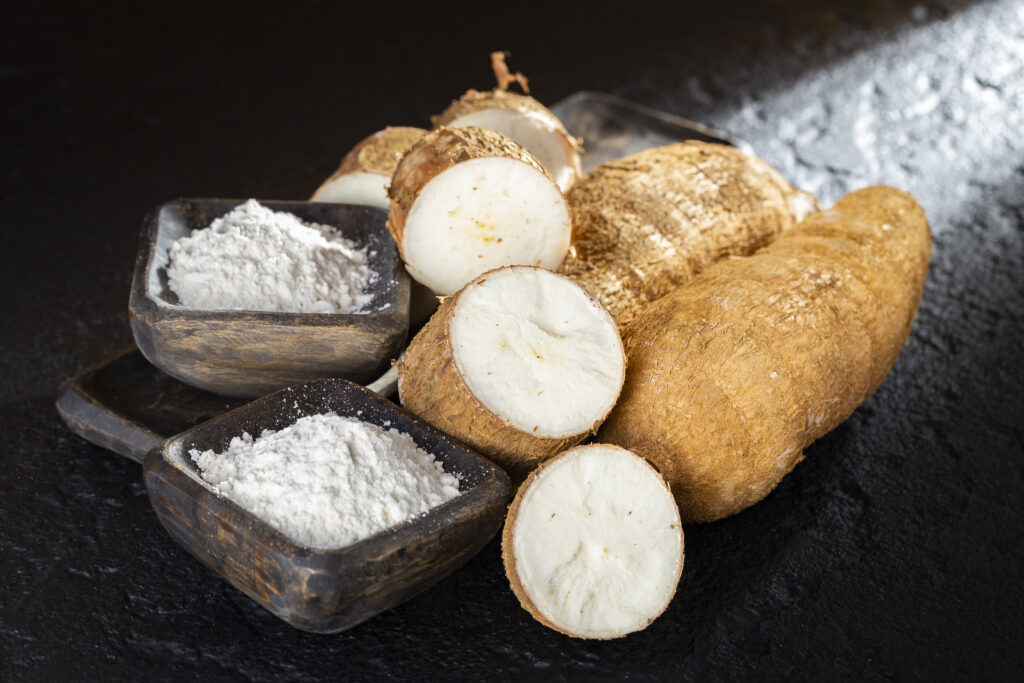Tapioca starch has become a notable ingredient in today’s dynamic food business, where consumers are increasingly looking for healthier and cleaner solutions. This understated yet adaptable ingredient has been subtly altering the flavor, texture, and quality of our culinary products.
Tapioca starch thrives as the demand for gluten-free and clean-label options grows. Its special qualities improve everything from dairy-free ice cream to gluten-free bread. This blog post examines tapioca starch’s function in the food business, from its characteristics to cutting-edge uses and how it raises food items for improved sustainability, taste, and quality.
Tapioca Starch: A Food Industry Game-Changer
The outstanding characteristics and numerous advantages of tapioca starch set the stage for the transformation of the food business. Its singular capacity to enhance texture is one of its distinguishing characteristics. For instance, tapioca starch makes gluten-free bread more palatable by preserving the desired structure and softness in every bite.
Further, tapioca starch is essential for maintaining moisture, which is just the beginning. It assists in keeping these products deliciously moist, ensuring a pleasurable eating experience, in applications like dairy-free sweets or gluten-free pastries. Furthermore, one cannot ignore its effect on shelf life. The use of tapioca starch helps the food sector be more sustainable by reducing waste, extending the shelf life of diverse foods, and preserving food.
Market Trends and Insights
Being aware of market trends is crucial in the always changing food sector, and the demand for clean-label and gluten-free ingredients has been on the rise. Consumers are reading product labels more closely, looking for transparency and healthier options. Food producers are therefore under pressure to supply goods that suit these desires. The natural and pure properties of tapioca starch make it the ideal choice. Its clean-label designation, which excludes artificial ingredients and allergens, makes it a great option for businesses trying to appeal to consumers who are health-conscious.
The popularity of tapioca starch is a further indication of the food industry’s increasing demand for it as a preferred ingredient. Tapioca starch’s flexibility knows no bounds—it may be used in both conventional dishes and cutting-edge, futuristic applications. It has earned a reputation as a standard ingredient thanks to its capacity to enhance the quality and texture of gluten-free products while preserving an unflavored flavor profile. Tapioca starch stands out as a dependable and efficient alternative as food producers work to meet the growing demand for gluten-free products, reflecting a general shift towards wholesome and environmentally friendly food options.
Innovations in Tapioca Starch Applications
Culinary innovation has been centered on tapioca starch, and successful case studies have changed the way that food is produced. For instance, tapioca starch has revolutionized the gluten-free baking industry by enabling soft and structurally sound bread. Tapioca starch’s adaptability in the world of inventive cuisine shines in unexpected areas, like dairy-free ice cream. These developments demonstrate how tapioca starch may improve a range of food items, from gluten-free inventions to updated classics.
In the future, tapioca starch is expected to play a bigger part in the food sector. It complies with the rising demand for sustainable, gluten-free, and clean-label products. It is anticipated that tapioca starch will keep growing, especially in the manufacture of products that are free of gluten.
The Future of Tapioca Starch in Food Manufacturing
In the future, tapioca starch is expected to play a bigger part in the food sector. It complies with the rising demand for sustainable, gluten-free, and clean-label products. It is anticipated that tapioca starch will keep growing, especially in the manufacture of products that are free of gluten.
Tapioca starch’s versatility is set to inspire experimentation across various culinary domains, from plant-based meats to distinctive confectionery creations, and it promises a flavorful, sustainable, and gluten-free future. In addition, exciting new applications and innovations are anticipated.
Success Stories: Brands That Embrace Tapioca Starch
Globally renowned companies like “GreenGourmet” have achieved extraordinary success in the ever-evolving food market by enthusiastically embracing tapioca starch. With its soft and delicious gluten-free bread, “GreenGourmet” has transformed the market, successfully fulfilling the demand’s growth and winning over consumers with its enhanced texture and flavor.
Similar to this, “DairyJoy,” a well-known dairy-free dessert juggernaut worldwide, uses tapioca starch to create incredibly smooth ice creams. Their tale exemplifies how tapioca starch may easily take the place of conventional ingredients while still producing mouthwatering flavors. The successes of these well-known businesses demonstrate how tapioca starch transforms the food manufacturing process, offering models for others in the sector to follow and achieve extraordinary results while enhancing their consumer relationships.
Conclusion
In summary, tapioca starch has become crucial for improving food products all around the world. Tapioca starch has been crucial in contemporary food production, from gluten-free bread by “GreenGourmet” to velvety dairy-free ice creams by “DairyJoy.” Its clean-label, adaptable qualities satisfy consumer desires for high-quality, dietary-aware solutions.
In line with consumers’ preferences for higher-quality, environmentally responsible options, tapioca starch is more than simply a passing fad. By investigating its uses and practicing ethical sourcing, we make sure tapioca starch continues to influence the culinary scene and provides scrumptious and environmentally friendly solutions for years to come.
Image by alexanruiz via https://www.freepik.com/

